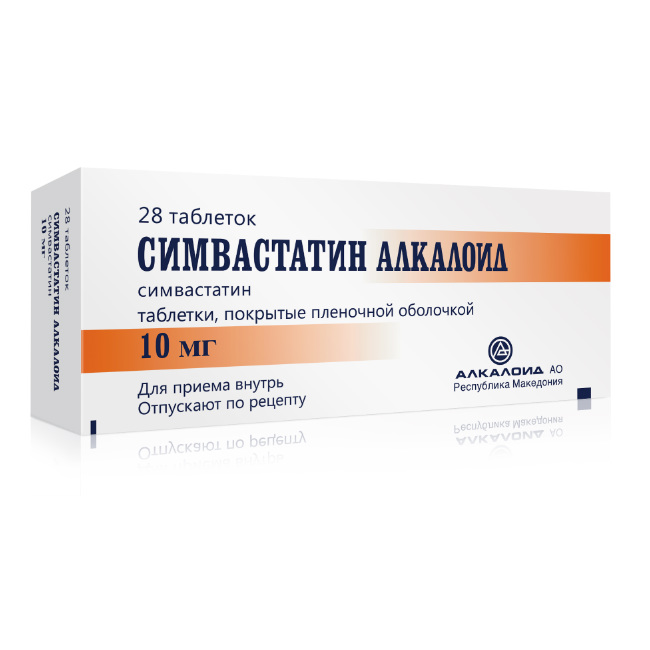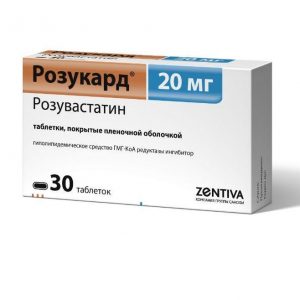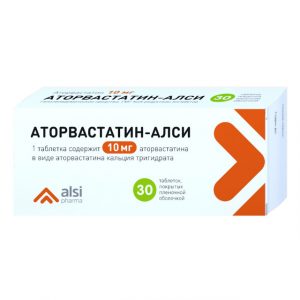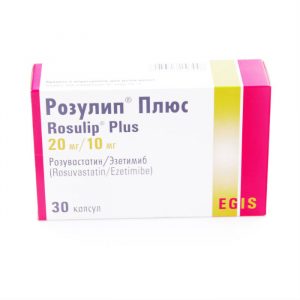Description
Release form
Film-coated tablets
Indications
Primary hypercholesterolemia of Pa and Ib type with ineffective diet therapy with low cholesterol and other non-medicated measures (physical activity and weight loss) in patients at increased risk of coronary atherosclerosis)
Combined hypercholesterolemia and hypercholesterolemia non-correctable special diet and exercise
Homozygous hereditary hypercholesterolemia (as an adjunct to lipid-lowering therapy)
Coronary heart disease (secondary prophylaxis):
is indicated for patients: to reduce overall mortality in order to reduce the risk of coronary mortality and prevent myocardial infarction from The goal is to reduce the risk of stroke and transient cerebrovascular accidents in order to slow the progression of coronary atherosclerosis.
Use during pregnancy and lactation
Simvastatin alkaloid is contraindicated in pregnancy.
Due to the fact that HMG-CoA reductase inhibitors inhibit cholesterol synthesis, and cholesterol and other products of its synthesis play a significant role in the development of the fetus, including the synthesis of steroids and cell membranes, Simvastatin Alkaloid may have an adverse effect on the fetus when it is prescribed to pregnant women (women of reproductive age should avoid conception). If pregnancy occurs during the treatment, the drug should be discontinued, and the woman should be warned of a possible danger to the fetus.
Withdrawal of lipid-lowering drugs during pregnancy does not significantly affect the results of long-term treatment of primary hypercholesterolemia.
The use of simvastatin alkaloid is not recommended in women of childbearing age who do not use contraceptives.
There are no data on the excretion of simvastatin with breast milk. If it is necessary to prescribe Simvastatin Alkaloid to women during feeding, it should be borne in mind that many drugs are excreted in breast milk, and there is a risk of severe reactions, therefore breastfeeding while taking the drug is not recommended.
Special instructions
At the beginning of therapy with simvastatin alkaloid, a transient increase in the activity of liver enzymes is possible.
Before starting therapy and then regularly conducting a study of liver function (monitor the activity of liver enzymes every 6 weeks for the first 3 months, then every 8 weeks for the remaining first year, and then once every six months), as well as with increasing doses, conduct a test to determine liver function. If the dose is increased to 80 mg, it is necessary to test every 3 months. With a persistent increase in the activity of hepatic transaminases (3 times compared with the initial level), the use of Simvastatin Alkaloid should be discontinued. Simvastatin Alkaloid, like other inhibitors of HMG-Co-A-reductase, should not be used with an increased risk of rhabdomyolysis and renal failure (against the background of severe acute infection, arterial hypotension, planned major surgery, injuries, severe metabolic disorders).
In patients with reduced thyroid function (hypothyroidism) or in the presence of certain kidney diseases (nephrotic syndrome) with increased cholesterol, the underlying disease should be treated first. Simvastatin alkaloid is prescribed with caution to people who abuse alcohol and / or have a history of liver disease.
Before and during treatment, the patient should be on a hypocholesterol diet. The simultaneous intake of grapefruit juice can increase the severity of side effects associated with the intake of Simvastatin Alkaloid, therefore, their simultaneous administration should be avoided. Simvastatin alkaloid ire is indicated in cases where there is type I, IV, and V hyperglyceridemia.
Treatment with simvastatin alkaloid can cause myopathy, leading to rhabdomyolysis and renal failure. The risk of this pathology increases in patients receiving at the same time as Simvastatin Alkaloid one or more of the following drugs: fibrates (gemfibrozil, fenofibrate), cyclosporine, nefazodone, macrolides (erythromycin, clarithromycin), antifungal agents from the azole group (ketoconazole), itracon drugs containing cobicistat and HIV protease inhibitors (ritonavir). The risk of developing myopathy also increases in patients with severe renal failure (creatinine clearance less than 30 ml / min). All patients starting therapy with Simvastatin Alkaloid, as well as patients who need to increase the dose of the drug, should be warned about the possibility of myopathy and the need to immediately consult a doctor in case of unexplained pain, muscle soreness, lethargy or muscle weakness, especially if it is accompanied by malaise or fever. Drug therapy should be discontinued immediately if myopathy is diagnosed or suspected.
In order to diagnose the development of myopathy, it is recommended to regularly evaluate the activity of CPK.
In the treatment with Simvastatin Alkaloid, an increase in the activity of serum CPK is possible, which should be taken into account in the differential diagnosis of pain in the sternum. The criterion for drug withdrawal is an increase in the activity of CPK in the blood serum by more than 10 times relative to the upper limits of the norm. In patients with myalgia, myasthenia and / or a marked increase in KFK activity, drug treatment is stopped.
The risk of developing myopathy may be increased due to the simultaneous use of fusidic acid with statins, including simvastatin. Isolated cases of rhabdomyolysis with the use of simvastatin have been reported. Temporary suspension of treatment with simvastatin may be considered. If such treatment is necessary, the condition of patients taking fusidic acid and simvastatin should be closely monitored.
The risk of developing myopathy / rhabdomyolysis The risk of developing myopathy and rhabdomyolysis increases with the simultaneous use of dronedarone and other drugs (see Interaction with other drugs).
The drug is effective both in monotherapy and in combination with skvestran gami bile acids.
If you miss the current dose, you must take the drug as soon as possible. If it is time to take the next dose, do not double the dose.
In patients with severe renal failure (creatinine clearance less than 30 ml / min), treatment is performed under the control of renal function. The duration of the drug is determined by the attending physician individually.
Composition Active ingredient:
simvastatin 10,000 mg.
Excipients:
ascorbic acid 2,500 mg
citric acid monohydrate 1,250 mg
butylhydroxytoluene 0,020 mg
microcrystalline cellulose 15,000 mg
lactose monohydrate 64,630 mg
mg starch
Shell:
opadray II pink 5,000 mg (for 10 mg and 20 mg tablets), or 10,000 mg (for 40 mg tablets) [polyvinyl alcohol, partially hydrolyzed titanium dioxide talc macrogol-3000 dye iron oxide red [pigment 30] [E 172] yellow iron dye oxide [pigment 10] [E 172]].
Dosage and administration of
Before and during treatment with simvastatin alkaloid, the patient should follow a hypocholesterol diet to lower cholesterol.
Simvastatin alkaloid to apply inside 1 time a day in the evening, washing down with a sufficient amount of water. The time of taking the drug should not be associated with a meal. Hypercholesterolemia:
The recommended initial dose is 5 mg 1 time / day (14 tablets of 10 mg), with severe hypercholesterolemia – 10 mg per day.
Correction of the dosage regimen can be carried out with an interval of 4 weeks. The maximum daily dose is 80 mg.
With homozygous familial hypercholesterolemia, the dose of Simvastatin Alkaloid is 40 mg / day in the evening or 80 mg / day, divided into 3 doses – the first – 20 mg, the second – 20 mg and 40 mg in the evening. Coronary heart disease (CHD):
In CHD, Simvastatin Alkaloid is prescribed in an initial dose of 20 mg 1 time / day in the evening, if necessary, the dose is gradually increased every 4 weeks to 40 mg.
In elderly patients and in patients with mild or moderate renal failure, changes in the dosage of the drug are not required.
In patients with chronic renal failure (creatinine clearance less than 30 ml / min) or receiving nicotinic acid in lipid lowering doses (> 1 g / day) in combination with simvastatin alkaloid, the maximum recommended dose of simvastatin alkaloid should not exceed 10 mg per day.
For patients taking Simvastatin Alkaloid along with verapamil, diltiazem and fibrates, except for gemfibrozil (see Contraindications) or fenofibrate, the maximum recommended dose of Simvastatin Alkaloid is 10 mg per day.
For patients taking amiodarone, amlopidine or ranolazine concomitantly with the drug Simvastatin Alkaloid, the dose of the drug Simvastatin Alkaloid should not exceed 20 mg per day.
For patients taking Simvastatin Alkaloid along with dronedarone, the maximum daily dose of simvastatin should not exceed 10 mg.
Side effects
Side effects
There are reports of the possibility of the following adverse events (rare:> 0.01% and <0.1% very rare: <0.01% ns frequency is set: it is impossible to estimate the frequency based on available data) : Hematopoietic Rare: anemia. On the part of the skin Rare: skin rash, itching, alopecia. From the digestive system Rare: constipation, abdominal pain, flatulence, dyspepsia, diarrhea, nausea, vomiting, pancreatitis, hepatitis, cholestatic jaundice. Very rare: fatal and nonfatal liver failure From the central nervous system and sensory organs Rare: headache, dizziness, peripheral neuropathy, paresthesia. Very rare: insomnia, impaired memory. Frequency not established: depression, blurred visual perception, violation of taste sensations. From the musculoskeletal system Rare: myopathy, myalgia, muscle cramps, rhabdomyolysis with acute renal failure (due to rhabdomyolysis) or without. Frequency not established: tendinopathy, possibly with rupture of the tendons of myasthenia gravis. Respiratory Frequency not found: interstitial lung disease (especially with prolonged use). From the reproductive system Frequency ns established: erectile dysfunction. General disorders and disorders at the site of administration of Rare: asthenia. Allergic and immunopathological reactions Hypersensitivity syndrome has rarely developed, which manifested itself as angioedema, lupus-like syndrome, rheumatic hilarimialgia, dermatomyositis, vasculitis, thrombocytopenia, arrhythmiasis, arrhythmias, erythrocytomyocenosis, erythrocytomyocenia, erythrocytomyocenosis, erythrocytomyocenosis, erythrocytomyocenitis, , flushing of the face, shortness of breath and general weakness. Very rare reports have been received of the development of immuno-mediated necrotizing myopathy due to statin use. Laboratory displays and Rare: increased activity of hepatic transaminases, alkaline phosphatase and gamma glutamyl transpeptidase, krsatin phosphokinase (CPK). An increase in glycosylated hemoglobin concentration and fasting serum glucose concentration has been reported with statins, including simvastatin. Other Frequency not found: palpitations. Rare reports of cognitive impairment have been received (for example, various memory impairments: forgetfulness, memory loss, amnesia, confusion) associated with the use of statins. The following adverse events have been reported with certain statins: sleep disturbances, including insomnia and nightmares, sexual dysfunction, gynecomastia. If any of the side effects indicated in the instructions are aggravated, or you notice any other side effects not listed in the instructions, inform your doctor. Drug interaction Interaction with other drugs Contraindicated combinations: strong inhibitors of the isoenzyme CYP3A4 increase the risk of myopathy due to a decrease in the excretion rate of simvastatin. The simultaneous use of potent inhibitors of the CYP3A4 isoenzyme (for example, itraconazole, voriconazole, ketoconazole, posaconazole, HIV protease inhibitors, boceprevir, telaprevir, erythromycin, clarithromycin, telithromycin and nefazodone, antiperspirant and antiviral drugs). . Cytostatics, immunosuppressants: increase the risk of myopathy. Gemfibrozil, cyclosporine, or danazole: since the risk of developing myopathy / rhabdomyolysis increases when used together with high doses of simvastatin, simultaneous use is contraindicated (see section Contraindications), Other fibrates: the risk of developing myopathy increases with the simultaneous use of simvastatin with gemfibrozil and other fibrates (except for fsnofibrat). These lipid-lowering drugs can cause myopathy in monotherapy. With the simultaneous use of simvastatin with fenofibrate, the risk of developing myopathy did not exceed the sum of the risks with monotherapy with each drug. Nicotinic acid in lipid lowering doses (more than 1 g / day): with the simultaneous use of simvastatin and nicotinic acid in lipid lowering doses (more than 1 g / day), cases of the development of myopathy / rhabdomyolysis are described. Amiodarone and verapamich: the risk of developing myopathy increases with the combined use of amiodarone or verapamil with high doses of simvastatin. Diltiazem: the risk of developing myopathy increases slightly in patients receiving diltiazem concomitantly with simvastatin at a dose of 80 mg. Simvastatin potentiates the action of peroral anticoagulants (e.g. fenprocoumon, warfarin) and increases the risk of bleeding, which requires the monitoring of blood coagulation parameters before treatment, as well as often enough in the initial period of therapy. As soon as a stable level of prothrombin time index or International Normalized Ratio (MPO) is reached, its further monitoring should be carried out at intervals recommended for patients receiving anticoagulant therapy. When changing the dosage or stop taking simvastatin, prothrombin time or INR should also be monitored according to the above scheme. Therapy with simvastatin ns causes changes in prothrombin time and the risk of bleeding in patients not taking anticoagulants. Increases the concentration of digoxin in blood plasma. Colestyramine and colestipol reduce bioavailability (the use of simvastatin is possible 4 hours after taking these drugs, with an additive effect). Fusidic acid: With the simultaneous use of fusidic acid and simvastatin, the risk of developing myopathy may increase. Colchicine: there have been reports of myopathy and rhabdomyolysis with the simultaneous administration of colchicine and simvastatin in patients with renal failure. In combination therapy with these drugs, such patients should be closely monitored. Grapefruit juice contains one or more components, which inhibit the CYP3A4 isoenzyme and can increase the plasma concentration of drugs metabolized by the CYP3A4 isoenzyme. An increase in the activity of HMG-CoA reductase inhibitors after consuming 250 ml of juice per day is minimal and ns has clinical significance. However, the consumption of a large volume of juice (more than 1 liter per day) when taking simvastatin significantly increases the level of inhibitory activity against HMG-CoA reductase in the blood plasma. In this regard, it is necessary to avoid the consumption of grapefruit juice in large quantities. Voricopazole: concomitant use is contraindicated. Droedaron: concomitant use increases the risk of myopathy and rhabdomyolysis. Moderate inhibitors of the CYP3A4 isoenzyme: with the simultaneous use of drugs with moderate inhibitory activity against the CYP3A4 isoenzyme and simvastatin, especially at higher doses, the risk of developing myopathy may increase. Overdose of In none of the several known cases of overdose (maximum dose of 450 mg), specific symptoms were detected. Treatment: induce vomiting, take activated charcoal. Symptomatic Therapy It should monitor liver and kidney function, the level of CPK in the blood serum. With the development of myopathy with rhabdomyolysis and acute renal failure (a rare but severe side effect), the drug should be stopped immediately and the patient should be given diuretic and sodium bicarbonate (intravenous infusion). If necessary, hemodialysis is indicated. Rhabdomyolysis can cause hyperkalemia, which can be eliminated by intravenous administration of calcium chloride or calcium gluconate, glucose infusion with insulin, potassium ion exchangers, or, in severe cases, using hemodialysis. Storage conditions In a dark place, at a temperature of 15 to 25 ° C. Keep out of the reach and sight of children. Expiration 2 years. active substance simvastatin Conditions dispensation from pharmacies prescription lekarstvennaja form tablets




